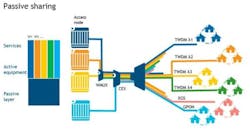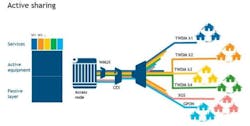Today, network providers have several options when it comes to investing in next-generation PON technology. However, in the race to more effectively monetize network investments, address growing needs for symmetrical bandwidth, and better serve future evolving end-user demands, network providers are increasingly turning to time and wavelength division multiplexed PON (TWDM-PON). Why? For many, it starts with the flexibility the technology provides.
Unlike GPON or XG-PON1, TWDM-PON offers up to four wavelength pairs (eight in the future) that can each be configured at different bitrates (10G/10G, 10G/2.5G, 2.5G/2.5G) to best address the specific requirements of residential, business, or backhaul services. Providing up to 10-Gbps symmetrical speeds on each wavelength, TWDM-PON enables operators to easily differentiate existing residential service offerings and efficiently capture new revenue opportunities at the enterprise level. The technology also facilitates a multi-service access approach that enables the convergence of services onto a single architecture, which helps to further accelerate the monetization of fiber networks. With the flexibility to add wavelengths one by one, service providers can effectively scale their fiber networks and seamlessly evolve network capacity from 10 Gbps to 40 Gbps, and beyond, as demand grows in the future.
Julie Kunstler, principal analyst at Ovum, has commented on this trend, saying:
"TWDM-PON's ability to support different types of subscribers or applications through the use of different wavelengths, and different bit rates on those wavelengths, provides a significant advantage over other next-gen PON technology. The technology's ability to simultaneously support more subscribers, more applications, and even network sharing leads to faster network monetization, which is important given the costs associated with building an FTTx network."
In addition to some of these well-known benefits, TWDM-PON also provides a unique capability -- wavelength unbundling -- that is changing the economics of fiber networks. This feature can help network providers secure additional revenue from wholesale opportunities, reduce business risk through network infrastructure co-investment, accelerate fiber deployments, and reduce overall costs.
How? In considering TWDM unbundling scenarios, it helps to look at the network as consisting of three separate layers:
- The bottom (passive) layer, composed of network elements that are not subject to frequent changes, such as ducts, poles, dark fiber, and splitters.
- The middle (active) layer, composed of active elements such as access nodes and end-user modems, which are subject to moderate change due to innovations in technology.
- The top (service) layer, composed of residential, public, and business services; these elements often are subject to significant change due to constant shifts in the market and customer preferences.
Implementing TWDM-PON Technology
The actual unbundling in TWDM-PON networks can be done in three ways:
The scenario a network provider ultimately implements can be influenced by the infrastructure, technology available in the network, the organizations involved, and each organizations' motivations. However, the flexibility available through TWDM-PON provides more options from which operators can choose to best meet their specific business-model needs.
TWDM makes it possible to have up to four service providers (each with their own wavelength) on a single network, which is sufficient for most markets. Because TWDM can co-exist with other PON technologies, it also leaves plenty of room for operators to grow and add wavelengths as needed. As a result, today operators are able to run a GPON network, add TWDM on the same network, and then source out the wavelengths to service providers or keep them for their own future needs and operational use.
Different Sharing Models and Their Benefits
TWDM-PON shows great promise for deployment across both new "greenfield" networks and existing "brownfield" fiber networks with an objective for further growth. Operators increasingly consider TWDM-PON the technology of choice for both applications.
In both scenarios, operators can generate new revenue streams, create more capacity, and have more flexibility in offering wholesale services. Here's how:
- In a brownfield scenario, where the wholesale operator owns the bottom (passive) and middle (active) network layers, the wavelength unbundling can occur on either layer; full separation is very unlikely to happen. In the case of passive sharing, the new entrants would deploy and operate their own access nodes on a dedicated wavelength. In the case of active sharing, the new entrants would be served from the access node owned by the wholesale provider. The latter is a simpler approach, as all network elements are managed by one entity (the wholesale provider). Adding TWDM on an existing GPON network is easy, as both technologies can co-exist on the same fiber plant, using the same passive plant and access node. The wholesale operator will need to add a new network element, called a co-existing element, which multiplexes GPON and TWDM signals on the same fiber. Growth can be managed gradually. For instance, if only one service provider is using one wavelength, the network operator can choose to use the other wavelengths for operations or future enhancements. TWDM-PON in brownfield creates potential new revenue-generating opportunities through wavelength wholesale.
- In a greenfield scenario, any of the unbundling models are possible and likely to happen. The network should be designed from the start to support wavelength unbundling; growth can be managed gradually by adding a wavelength for each new entrant. This scenario is particularly interesting for municipalities, utilities, or joint ventures for co-investment in a common network. As a result, unbundling encourages investments in fiber networks, as the cost and risks are shared. The advanced properties of TWDM-PON, such as high capacity, independence in evolving the capacity, etc., will also attract more service providers, resulting in better network monetization and better service offerings for end-users.
Achieving Additional Flexibility with TWDM-PON and Wavelength Mobility
Wavelength mobility is another unique characteristic of TWDM-PON technology that can benefit both multi- and mono-operator environments.
In a mono-operator network, for instance, wavelength mobility can be used for bandwidth rebalancing or creating operational efficiencies (e.g., during maintenance work or low-usage hours). In multi-operator unbundling scenarios, wavelength mobility can help streamline processes.
For instance, if an end-user wanted to switch service providers today, the task would often require a truck-roll and replacing the user equipment (ONT). With tunable TWDM-PON, an operator can simply change an end-user's wavelength directly from the central office – assuming there is interoperability between the access node and the ONUs. In the active sharing scenario, this is not an issue because one organization (the wholesale provider) controls all the active elements. Therefore, the assignment of wavelengths does not require complex, multi-vendor inter-node synchronization mechanisms.
However, in a passive sharing model, where each service provider has its own access node, there is a need for communication on a higher level to ensure synchronization between all access nodes. Currently, a standard protocol for this communication is under discussion within the Broadband Forum; it would prevent unauthorized switching of wavelengths and would ensure transparency for both end-users and service providers. These standards-based applications are expected to be ready within the 2018-19 timeframe.
TWDM-PON Drives Demand in 2016 and Beyond
With its promise of enhanced flexibility, more capacity, and new potential revenue streams, TWDM-PON is capturing the attention of operators everywhere. In early 2015, for example, several large operators and utility companies – including Vodafone in Spain and Energia in Japan – announced trials around the technology. Additionally, EPB in Chattanooga, TN, announced the first community-wide deployment of TWDM-PON as part of a growing effort to bring 10-Gbps services to all residential and business customers in the area.
As demands and requirements continue to evolve, TWDM-PON affords operators a new way to future proof their network, increase revenues, and accelerate the monetization of their network investments.
Ana Pesovic



